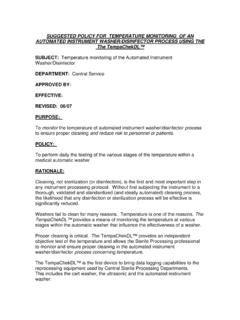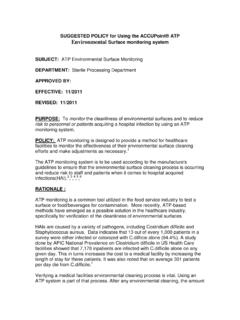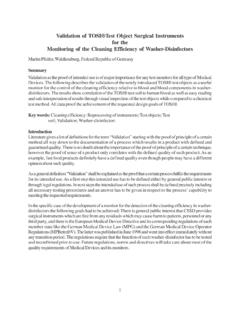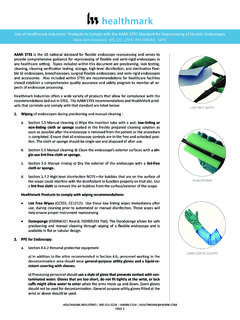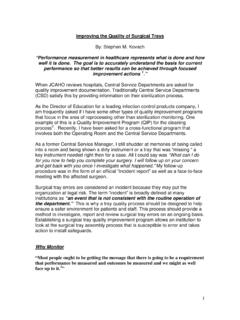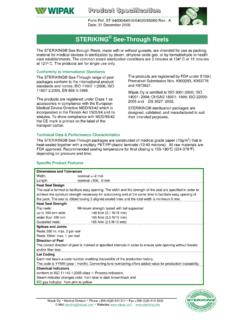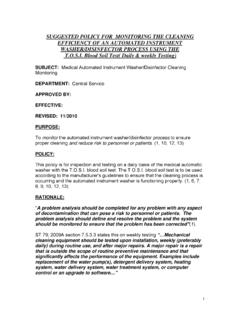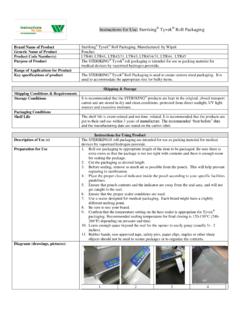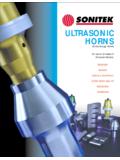Transcription of SUGGESTED POLICY FOR THE MONITORING OF THE …
1 SUGGESTED POLICY FOR. THE MONITORING OF THE CLEANING EFFICIENCY OF. ultrasonic CLEANERS (SONOCHECK ONLY). SUBJECT: ultrasonic CLEANER MONITORING . DEPARTMENT: Central Service APPROVED BY: EFFECTIVE: REVISED: 2/13. PURPOSE: To monitor the ultrasonic CLEANING process at least weekly (preferably daily) to ensure proper cleaning and reduce risk of infection to personnel or patients.(1,10,13,14). POLICY : SONOCHECK kit is designed to monitor the cleaning function of an ultrasonic CLEANER. To ensure that the ultrasonic process is cleaning properly, a sonic check test kit should be used to monitor the occurrence of cleaning instruments. The sonic test kit is to be used according to the manufacture's guidelines to ensure that the cleaning process is occurring and the ultrasonic cleaner is functioning properly. (1,6,7,8,9,1013,14). RATIONALE : ST 79; 2009A section states this on weekly testing Mechanical cleaning equipment should be tested upon installation, weekly (preferably daily) during routine use, and after major repairs.
2 A major repair is a repair that is outside the scope of routine preventive maintenance and that significantly affects the performance of the equipment. Examples include replacement of the water pump(s), detergent delivery system, heating system, water delivery system, water treatment system, or computer control or an upgrade to software Sonic cleaners are considered mechanical cleaning equipment by AAMI. "Cleaning, not sterilization (or disinfection) is the first and most important step in any instrument processing protocol. Without first subjecting the instrument to a thorough, validated and standardized (and ideally automated) cleaning process, the likelihood that any disinfection or sterilization process will be effective is significantly reduced". (11). The ultrasonic cleaning process cleans dirty surgical instruments so they can be handled safely, repackaged, and sterilized for a future surgery. The danger of handling instruments contaminated with blood is obvious in this age of hepatitis, CJD and HIV.
3 The procedures for sterilizing instruments are based on years of scientific testing of cleaning instruments. If surgical instruments are not clean, the procedures are ineffective. Dried blood on instruments is hazardous to the employees of the hospital and to the next surgical patient upon which the instruments are used. (1,2,3,4,8,). An ultrasonic cleaner enables thorough cleaning of equipment by ultrasonic agitation that dislodges soil from instruments. ultrasonic cleaners do not disinfect instruments. They are used to assist with the cleaning of instruments that cannot be adequately cleaned manually such as spiral wound instruments like biopsy forceps. ultrasonic vibration at the frequency used for cleaning does not kill microorganisms and infective aerosols may be produced. It is for this reason that the lid of the tank must be tightly closed during operation. ultrasonic cleaners work by subjecting instruments to high frequency, high- energy sound waves.
4 This causes the soil to be dislodged from instruments and drop to the bottom of the tank, or be sufficiently loosened that it will be removed during the rinsing process. The detergent used in the ultrasonic tank must be carefully selected in accordance with advice from the tank's manufacturer. Optimally it will be a neutral, low-foaming product and enzymatic cleaners will have enhanced benefits in this process. Degassing of cleaning solutions is extremely important in achieving satisfactory cleaning results. Fresh solutions or solutions which have cooled must be degassed before proceeding with cleaning. Degassing is done after the chemical is added and is accomplished by operating the ultrasonic energy and raising the solution temperature. The time required for degassing varies considerably, based on tank capacity and solution temperature, and may range from several minutes for a small tank to an hour or more for a large tank. An unheated tank may require several hours to degas.
5 Degassing is complete when small bubbles of gas cannot be seen rising to the surface of the liquid and a pattern of ripples can be seen. Routine cleaning Cleaning the ultrasonic cleaner and replacement of the cleaning solution is necessary at least daily or more frequently if solution soiled. Follow manufactures guidelines on changing solution. Performance testing The efficacy of the ultrasonic cleaner should be tested at a minimum weekly and daily if possible. The results of the testing shall be documented as part of the proof of process. Sonic cleaners fail for many reasons. Tests should provide a means of MONITORING the variables that influence the effectiveness of the ultrasonic cleaning process. Some of these variables are water, time, detergent, enzyme, temperature, high pH, agitation, speed, tray selection, initial heat, drying, obstructions, and insufficient amount of chemicals and equipment faliure. (7). Proper cleaning is critical. The SONOCHECK test kit provides an independent objective test of clean and allows the Sterile Processing professional to monitor and ensure proper cleaning in the sonic process.
6 (1). AAMI does list a sonic cleaner as a piece of medical equipment in section ; there are other references that support the minimum of weekly testing of all type of sonic equipment with or without retro flow pulse adapter . Section and ANNEX D states Health care personnel may perform verification tests as part of the overall quality assurance program. This verification may include the use of test devices that monitor the functionality of the cleaning equipment in cleaning surfaces and that ensure adequate fluid flow in equipment that has adaptors for lumened devices . Section states Mechanical cleaning equipment should be tested upon installation, weekly (preferably daily) during routine use, and after major repairs. A major repair is a repair that is outside the scope of routine preventive maintenance and that significantly affects the performance of the equipment. Examples include replacement of the water pump(s), detergent delivery system, heating system, water delivery system, water treatment system, or computer control or an upgrade to.
7 The 2011 AORN RP for Cleaning and Care of Surgical Instruments and Powered Equipment Recommendation XXII Quality section is now supporting the testing of mechanical instrument washers before initial use, weekly during service, and after major maintenance. JCAHO in standard it states that medical equipment is maintained, tested and inspected So in accordance with ANSI/AAMI ST79-2009; ANSI/AAMI TIR12-2005; JCAHO. , and AORN, Healthmark recommends at least weekly MONITORING of the cleaning efficacy of any sonic cleaning unit with the following verification tests: Verification of sufficient cavitation energy with the Sonocheck . MONITORING vials*. Designed to change color (blue/green to yellow) when the ultrasonic cleaner is supplying sufficient energy and conditions are correct (degassed water, temperature, etc.) the Sonocheck is an easy to use and interpret method for MONITORING cavitation energy. Failure to change color indicates that either the sonic bath conditions were not correct, or a failure of one or more of the ultrasonic transducers.
8 PROCEDURE: "A problem analysis should be completed for any problem with any aspect of decontamination that can pose a risk to personnel or patients. The problem analysis should define and resolve the problem and the system should be monitored to ensure that the problem has been corrected"(21). SONOCHECK . Directions for use Safety lid Indicator solution Nuclei for cavitation Daily Inspection & Testing Follow manufacture guidelines concerning the daily inspection of equipment (screens, tank condition, filters, ). Remember each Sonic unit is different and staff should be trained on operation and inspection and cleaning of the equipment at least yearly Inspect the level of the detergent daily (mark the container of the solution daily with the date at the level of the solution in the container) this will allow a visual inspection if the solution is actual being used Log all observations in a report as daily observations Report any concerns to the proper management staff within the department to address Types of Testing of the Sonic Cleaner with the SONOCHECK.
9 The functional test will check the uniform operation of the empty ultrasonic cleaner's tank. This testing should be done on installation of the equipment and or after major repairs. The diagram below gives the SUGGESTED placement of SonoChecks in relation to the sonic tank size. Remember that degassing should always be done before any testing cycle begins. Record all results for trend analysis and for help in any troubleshooting issues. x x x x x Small up to 5 ltrs or ( gals). x x x Medium size tank x x x 5 to 20 ltrs or ( 5 gals). x x x x x x x Large above 20 ltrs or greater than 5 gals. x x x x x x x x Routine Testing of the Sonic Cleaner The routine test will also monitor the performance of the sonic cleaner. The routine test is performed under normal conditions in an empty tank that has been degassed. Frequency of testing should be at least weekly but preferably daily. The diagram below gives the SUGGESTED placement of SONOCHECK in relation to the sonic tank size for routine testing.
10 All testing results should be logged and saved for trend analysis and troubleshooting concerns. x Small up to 5 litres or ( gals). x x Medium size tank 5 to 20 liters or ( 5 gals). x x x Large above 20 liters or greater than 5 gals. In case of unsatisfactory results of the SONOCHECK , please refer to the troubleshooting guide A more detailed testing may be required based on the results (a more routine testing and/or a functional testing, may be required). Record all information in log book Weekly Inspection and Testing of other factors tht can impact the Sonic cleaning process These tests are done weekly. Is a complete testing of all of the inputs of the ultrasonic process (temperature, ph, hardness ). Equipment Inspection Inspect equipment (screens ) according to the manufacture instructions. Clean as needed Water Quality Follow these directions first for cold water, then hot water Use a AquaTest (wts-101) test strip Dip entire strip into water for 5 seconds, then remove.

